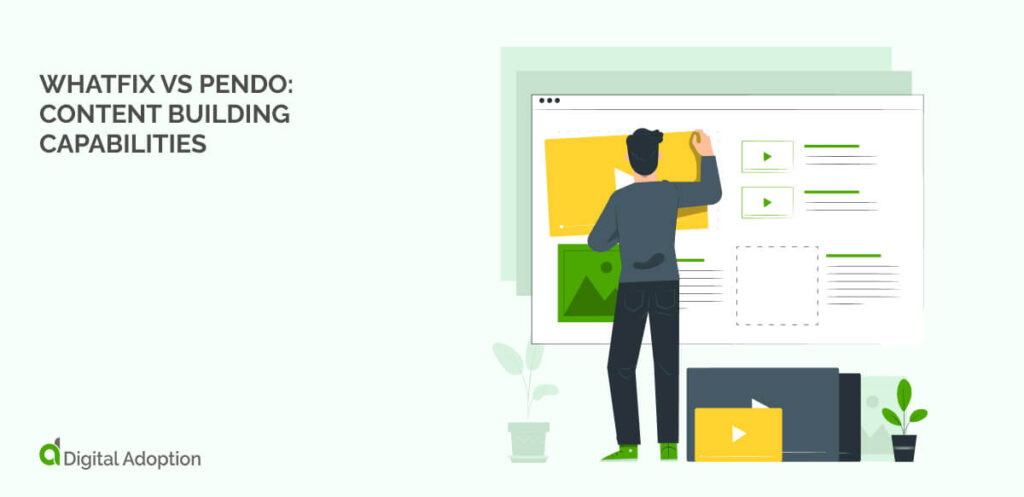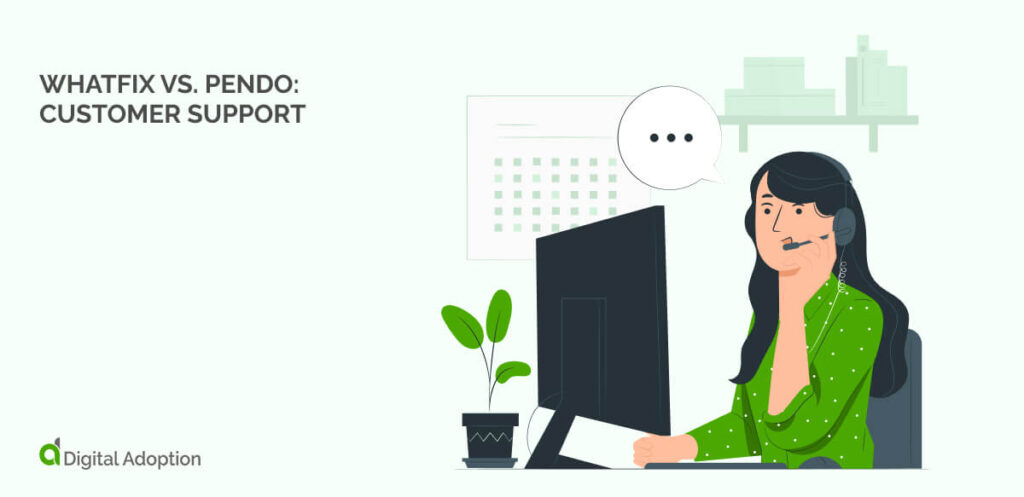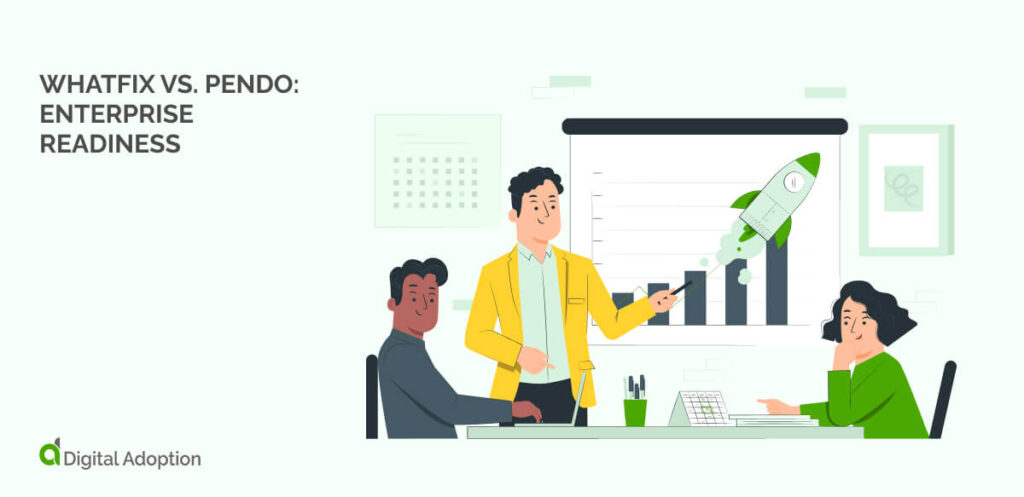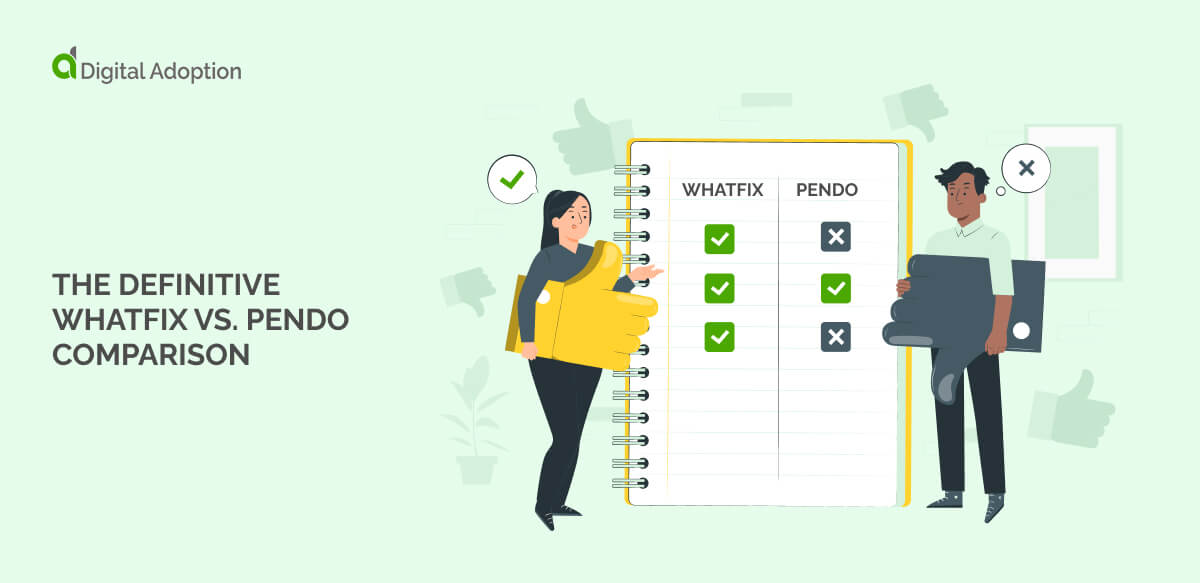Choosing the right Digital Adoption Platform (DAP) is key to ensuring smooth operations and achieving optimal user experiences. This article provides an in-depth comparison between two leading platforms in the DAP space: Whatfix and Pendo.
These platforms are compared across various parameters including advanced automation, customer experience, enterprise readiness, customer support, pricing structure, and unique advantages. As the field continues to evolve, and these platforms roll out new features and enhancements, it is important to note that this page will be updated regularly to reflect the most current information.
Both Whatfix and Pendo are well received by users and industry analysts. But not all DAP solutions were created equal. So, how can you know which is right for you? The first step would be to outline your objectives and priorities beyond the need to streamline onboarding and training with walkthroughs.
This may include accessing user behavior insights, automating tasks, applying cross-app analytics, and optimizing software licensing, among others.
Once you’ve got your list in hand, a side-by-side comparison of features, capabilities, and user feedback will go a long way towards helping you gain clarity about which solution is best suited for your organization’s digital adoption needs.
- Whatfix and Pendo at a glance
- What reviewers say
- What reviewers say
- The lowdown on features: Whatfix & Pendo side-by-side
- Whatfix & Pendo: a deeper look at key DAP features & capabilities
- Data centricity
- Whatfix vs Pendo: Content building capabilities
- Whatfix vs. Pendo: Automation and workflow support
- Whatfix vs. Pendo: Customer support
- Whatfix vs. Pendo: Business value and ROI
- Whatfix vs. Pendo: Enterprise readiness
- Whatfix vs. Pendo pricing comparison
- Which is best for you?
Whatfix and Pendo at a glance
Whatfix is well known for offering an affordable platform that performs well on delivering core DAP functionalities. The platform is focused on streamlining enterprise software onboarding and providing real-time task guidance for reducing the number of inquiries that the help desk receives.
The Whatfix solution is best suited for organizations that have prioritized quick wins over customization depth and self-serve independence.
Pendo is primarily a product experience platform that also offers certain capabilities for supporting digital adoption. These include guided workflows, an in-app resource center, and in-app feedback.
The company offers two products. One addresses the customer use case, while the other supports the employee use case, both through the prism of product experience.
What reviewers say
What reviewers say
Whatfix comes in with solid reviews, earning positive feedback regarding the platform’s overall capabilities and customer service. The offering is noted for its core functionalities for enterprise software onboarding and real-time task guidance.
Though it’s important to note that reviewers would like to see more customization options and to avoid the need for technical support when making certain configurations and content updates.
As for Pendo, the platform is appreciated by users in organizations with simple workflows and more modest DAP requirements.
For those who are more focused on product experience, the guided workflows, in-app resource center, and in-app feedback are well regarded.
Though, users also comment that design options for personalization and customizations are restricted and some implementation processes require IT assistance.
The lowdown on features: Whatfix & Pendo side-by-side
Whatfix & Pendo: a deeper look at key DAP features & capabilities
Data centricity
When comparing Whatfix and Pendo’s data and analytics capabilities, several key differences emerge.
Whatfix provides usage analytics that offer visibility into user interactions, helping identify the most and least used content. However, the analytics are sometimes viewed as unclear and lacking in providing comprehensive insights.
The platform is considered suitable for less complex deployments but lacks the depth of insight and predictive capabilities necessary for adjusting in-app guidance content and flows. This limitation, however, doesn’t diminish the usefulness of the platform for businesses seeking basic user behavior analysis.
Beyond simple activity reports, addressing more complex needs with Whatfix requires an IT-level understanding of how data is tracked and monitored. Moreover, while the organization can get reports on user interactions, discovering applications and related interactions is coding intensive.
Pendo, on the other hand, is noted for its robust data and analytics capabilities. The platform provides detailed user analytics, including heatmaps, user path analysis, and funnel tracking. These features offer a deeper understanding of user behavior and engagement, allowing businesses to optimize their product and marketing strategies effectively.
Pendo’s analytics are considered more comprehensive and insightful than those of Whatfix, making it a more suitable choice for businesses needing advanced, sophisticated user analytics. In the Pendo platform elements need to be tagged, session playbacks are not possible, and custom reporting has been noted to be cumbersome.
However, it’s important to note that both platforms come with their own sets of pros and cons. The choice between them ultimately depends on the specific data and analytics needs of the business.
Whatfix vs Pendo: Content building capabilities
Content creation and building capabilities form the core of any digital adoption platform, determining how effectively and easily in-app guidance content can be generated and tailored to meet user needs.
Whatfix excels in providing a simple and streamlined content creation process. The platform offers intuitive, no-code tools for creating interactive walkthroughs and guides, thereby lowering the barrier to content creation for non-technical users. The platform also allows for customization of features like welcome messages, pop-up triggers, and flow segmenting, enhancing user engagement and experience. However, some users have expressed the desire for more flexibility in customizing conditions, triggers, and logic that control behaviors.
Pendo, in contrast, is well-regarded for its dynamic content creation capabilities. It offers a comprehensive set of tools for creating customized in-app messages, tooltips, and guides. Pendo’s content building capabilities are more advanced than Whatfix’s, featuring a broad array of customization options and a more detailed interface. This can, however, result in a steeper learning curve for new users.
And with Pendo, since the company has been traditionally focused on customer experience rather than in-app guidance, the Pendo Editor does not have the features required for addressing complex flows and processes.
While Whatfix provides an easy to use, no-code content creation process, Pendo offers more sophisticated and flexible content creation capabilities. The choice between the two will depend largely on the complexity of the content needs of the business and the level of customization required.

Whatfix vs. Pendo: Automation and workflow support
Automation and workflow support are vital features in a digital adoption platform, ensuring streamlined processes and efficient task execution.
Whatfix provides decent automation support, offering features such as auto-generating walkthroughs, which reduces the manual effort in content creation. It also includes automation in its analytics, for instance, generating automated reports that help businesses track user behavior without manual intervention.
Additionally, Whatfix supports task list creation that guides users through a series of tasks, improving workflow and user productivity. However, there has been some user feedback regarding the desire for more advanced automation features, such as conditional automation based on user behavior or response. Whatfix offers a simple and streamlined approach to automation and workflow support, ideal for businesses with less complex needs.
Pendo, alternatively, stands out in providing robust automation and workflow support. It offers features like auto-guide dispatch, which automatically displays guides to users based on pre-defined conditions, and automated customer segmentation, which categorizes users based on their behavior. This results in personalized user experiences and more targeted guidance.
Furthermore, Pendo supports the creation of sophisticated user paths, which guide users through complex tasks and workflows, thereby enhancing productivity. However, the depth of Pendo’s automation capabilities could lead to a steeper learning curve for new users.
Whatfix vs. Pendo: Customer support
Customer support and success are key components of any tech solution, and both Whatfix and Pendo have demonstrated commitment in this area, albeit with distinct strategies.
Whatfix is often commended for its customer-focused approach, with users mentioning the responsive and knowledgeable customer support team. They’ve shown dedication in providing continuous product improvements based on customer feedback, which has earned them the reputation of a customer-centric company.
However, there have been instances of technical errors and bugs disrupting usage, causing some customers to feel a need for more robust technical support and faster problem resolution.
On the other hand, Pendo does not fall short in customer support and success either. They have a help center and offer an extensive range of resources such as guides, webinars, and tutorials. Pendo’s support team is also highly responsive and generally resolves customer issues effectively. Some users, however, have found Pendo’s onboarding process to be complex and felt a need for more hands-on assistance during the initial setup phase.
In a nutshell, while Whatfix has a customer-focused approach with quick response times, Pendo provides comprehensive resources and robust support. Both platforms have room for improvements: Whatfix in addressing technical issues and Pendo in assisting users throughout the onboarding process.

Whatfix vs. Pendo: Business value and ROI
When assessing the value and ROI of Whatfix and Pendo, both platforms showcase a notable capacity to drive user engagement, improve productivity, and enhance customer satisfaction.
Whatfix excels in its commitment to improving user experience with its intuitive user interface, simplified content creation, and effective analytics-driven insights. Customers report a significant reduction in training and support costs, faster onboarding, and increased user engagement, all leading to enhanced productivity and performance. Moreover, the tool’s impact extends to improving sales processes, boosting conversions, and fostering customer independence and self-sufficiency, thus resulting in a positive ROI.
Pendo, on the other hand, stands out with its robust data and analytics capabilities. It provides comprehensive user analytics including heatmaps, path analysis, and funnel tracking. This deeper understanding of user behavior and engagement allows businesses to optimize their product and marketing strategies effectively.
Additionally, Pendo’s dynamic content creation capabilities offer a wide array of customisation options, making it more suitable for businesses needing advanced and sophisticated user analytics. While this might involve a steeper learning curve for new users, the long-term benefits in terms of user engagement and customer satisfaction could lead to remarkable ROI.
Whatfix vs. Pendo: Enterprise readiness
Whatfix offers a digital adoption platform that provides core functionalities for enterprise software onboarding and real-time task guidance, which are best suited for product managers at enterprise and mid-market organizations.
The platform’s simplicity and user-friendliness is attractive for small to mid-size enterprises or for those seeking a simplified implementation.
Pendo is better suited for mid-market organizations and small businesses. Some design options for personalization and customizations are restricted, implementation processes may require IT assistance, and the Pendo consolidated suite of tools is primarily aimed at reducing manual effort, rather than handling complex enterprise workflows.

Whatfix vs. Pendo pricing comparison
Whatfix
Whatfix has two main pricing packages – one for DAP and one for product analytics. The DAP package is then further broken down to web, desktop, mobile, and enterprise plans. For a web deployment, there are standard, premium, and pro options. The first two options are designed for employee or customer-facing applications, with the pro option intended for customer facing applications with over one million users.
Each web package option includes features such as in-app guidance, surveys, and content aggregation, with progressively more extensive capabilities depending on the package level. For example, surveys in the standard package are out-of-the-box, but in the premium package they may be customized.
The DAP desktop, mobile, and enterprise packages have two options – standard and premium, both for employee or customer facing applications, and each with a certain features set, based on the level selected.
The enterprise package is the only one that covers an unlimited number of web-based employee-facing applications.
The product analytics pricing package also comes with a standard or premium option. The standard package is designed for a cloud-based deployment plan that is available with any web, desktop, or enterprise plan. The premium package is designed for cloud-based deployment of web-based and desktop-based employee or customer-facing applications.
Among the features available in both are user action tagging, dashboards, funnel insights, event properties, and more, where the standard package allows for 25 tag user actions and the premium option is unlimited.
Pricing for each package is comprised of a flat fee along with user license fees, which are defined as based on the type of user who will access the application.
Whatfix product and service add-ons include out-of-the-box content templates, integrations, and analytics, white-labeling, professional services, and more.
Whatfix offers a free trial to interested organizations.
Pendo pricing structure
Pendo offers custom pricing that is based on monthly active users (MAU). The company offers three packages – free, growth, and portfolio.
The free option includes product analytics, in-app guides, net promoter score (NPS), and roadmaps.
The Growth package is designed for use with a single web or mobile app, and includes product analytics, in-app guides, Net Promoter Score (NPS), roadmaps, and cross-app reports.
And the Portfolio package includes all that the Growth package offers but is meant for organizations with multiple products and can be used across unlimited web and mobile apps.
Among the features available in each are in-app guides, sentiment via NPS and surveys, and roadmaps, with the free plan available for 500 active monthly users, and growth and portfolio as a custom offering.
Features that are not available in the free package include a product engagement score, guide experiments, cross-app journey reports, and more.
The Whatfix advantage: quick wins at an affordable price
Whatfix is well positioned for organizations seeking basic capabilities that accelerate enterprise software onboarding within a modest budgetary framework.
The platform offers simplified content creation for deploying real-time task guidance and reducing training and support efforts.
Without a breadth of self-serve features, Whatfix is better suited for teams who don’t especially need to be independent and don’t mind engaging with the company’s support team for realizing certain capabilities.
The Pendo advantage: enhancing the product experience
For some companies ensuring a smooth product experience is prioritized over securing digital proficiency. This is where Pendo has found its niche.
It offers an in-product resource center, a feedback solicitation tool, and the ability to categorize feedback. This way, teams can gain insights on features and usage and tweak products for an enhanced user experience, as based on real-life inputs.
Which is best for you?
Bottom line, which is best for you? As was noted in the beginning of the review, it all depends on what you need.
If you are looking for an easy-to-use, no-code solution with decent automation support and customer success commitment, Whatfix is a great option. It offers quick wins at affordable prices and can be beneficial for small to mid-size enterprises or organizations with less complex needs. If yours is an organization whose processes are not marked by complexity and you don’t mind workarounds to issues that are specific to your workflows, then Whatfix is for you.
With Whatfix you’ll get straightforward onboarding processes and affordability without the depth and breadth of a wider DAP offering.
On the other hand, if you need robust automation and workflow support, along with comprehensive analytics capabilities and advanced user engagement features, Pendo is worth considering. It may have a steeper learning curve and be more suitable for mid-market organizations or businesses with more sophisticated content needs.
Not every organization has prioritized full-fledged digital adoption with extensive customization and analytics. If your KPIs are driven by how employees and customers experience a product, Pendo has what you need.
Pendo is an excellent choice for a mid-market organization or small business looking for an intuitive and user-friendly approach to enhancing the product experience.
Ultimately, it is important to carefully evaluate your business’s unique requirements and goals before making a decision. Both Whatfix and Pendo offer valuable digital adoption solutions, but the best fit for your organization will depend on your specific needs and priorities. So, take the time to research and assess your options before making a decision. After all, investing in a digital adoption platform is an important decision that can greatly impact your business’s success.













